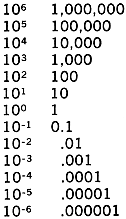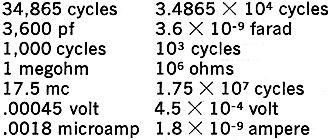|
August 1964 Radio-Electronics
 [Table of Contents] [Table of Contents]
Wax nostalgic about and learn from the history of early electronics.
See articles from Radio-Electronics,
published 1930-1988. All copyrights hereby acknowledged.
|
When in junior high, I never
cared much for math, other than being able to do just enough to get by. In fact,
I think I got a "D" in ninth grade algebra. My interest in all things mechanical
and electrical for some reason never engendered an attraction to anything other
than the simplest addition, subtraction, multiplication, and division. There were
no electronic pocket calculators in the day, and I had never heard of a slide rule.
Three years of an electrical vocational program in high school forced me to comprehend
and use a bit more math for
Ohm's law, Kirchhoff's law, some equations for magnetic
induction, and a little graphing of data points (not equations, though). Sometime
while in the USAF working as an air traffic control radar technician, I realized
that in order to pursue an engineering degree, being good at mathematics would be
a requirement. Beginning with a pre-algebra course in a community college, I worked
my way through algebra, calculus, differential equations, linear algebra, and geometry
courses, managing to get an "A" in every one of them. It was due to a passion to
be good at it. Throughout my electrical engineering curriculum courses, I saw time
and again that the guys who struggled with math either barely made it through, or
dropped out. Engineering courses are tough enough without having poor math skills
as an impediment. Being comfortable with logarithms made grasping decibels a cinch
since I understood the relationship where adding and subtracting decibels was the
equivalent of multiplying and dividing linear numbers. Working with exponents as
shown here is the same thing.
10 to the Many


Table I - Some Powers of 10
By Jerry L. Ogdin
Ever had one of those equations that turned out like Fig. 1? Well, read on, brother,
you've company!
Most technicians shy away from mathematics because of the assumed complexity,
but plenty of mathematicians wouldn't open a transistor radio for fear of getting
shocked.
I propose to show you how you can reduce those formulas with many numbers to
mere shadows of their former selves. Take another look at that formula in Fig. 1.
It's only the calculation of a coil and capacitor to resonate at 10 mc. Complex?
Now look at Fig. 2. Believe not, it's the same formula.

Fig. 1 - In this disarmingly simple formula, L is inductance
in henries, C capacitance in farads, and F frequency in cycles per second. All you
have to do is lose count of the zeros, and then where are you?

Fig. 2 - Same formula, same numbers, expressed a different way.
More convenient, because manipulation of powers of 10 uses just simple addition
and subtraction. Takes less space, too. Likelihood of errors is drastically reduced.
The power of ten
Ten is a funny kind of number, because we happen to have based our number system
on it. 10 times 10 is 100. 10 times 10 times 10 is 1,000. In other words, every
time we multiply by 10, we add a zero to the right side of the number. Odd, isn't
it? Instead of writing 10 times 10 times 10 ad nauseam, let's indicate how many
times 10 is multiplied by itself with a superscript. A superscript is a number placed
to the upper right of any other number. Thus, 10 multiplied by itself 5 times (which
equals 100,000) is 105. Note that this is different from 10 multiplied
by 5 (which equals 50). This system gives us multiples of 10 from 1 (100
equals 1) to as high as you'd like to carry it.
To get numbers between 0 and 1, we can divide 10 by itself as many times as necessary.
We show numbers between 0 and 1 with a negative superscript, one with a minus sign.
Therefore, 0.01 or 1/100 (1 divided by 10 times 10) is the same as 10-2.
The purpose of using the powers of 10 is to indicate large or small numbers conveniently.
For example, 1 mc is 1,000,000 cycles. From Table I, 1,000,000 is equal to 106
cycles.
Table I is only a guide, not a crutch. To find the power of 10 without using
the table, count all the digits in the number, and subtract one. For our example,
1,000,000 has seven digits. Subtracting one leaves six. Therefore, 1,000,000 is
equal to 106.

Table II - Some Examples
For decimals, count all the digits to the right of the decimal point, but do
not subtract. For another example, assume a 1-pf capacitor. 1 pf is equal to 0.000000000001
farad. Counting all the digits, we find there are 12. Because the number is a decimal,
the superscript will be negative. Therefore, 1 pf is equal to 10-12 farad.
Remember, use negative superscripts for decimals, and positive superscripts for
numbers 1 or larger.
What happens when you're working with some value that isn't evenly divisible
by 10? Well, just multiply. If we were solving our frequency example for 5 mc, we
could say that 5 mc equals 5 times 1 mc. Now solve for the power of 10 for 1 mc.
The answer is written
5 mc = 5 X 106 cycles
Using the system outlined above the answer will always be some number between
1 and 10, times some power of 10. Some examples are shown in Table II.
Let's summarize so far:
a. The superscript is positive for numbers 1 or over.
b. The superscript is negative for numbers less than 1.
c. The superscript may be found for numbers from 0 to 1 by counting the number
of digits to the right of the decimal point.
d. The superscript for numbers or more may be found by counting the number of
digits to the left of the decimal point, and subtracting one.
Rule One:
If two powers of 10 are multiplied together, just add the superscripts.
Examples: 1010 x 104 = 1014
106 x 10-3 = 103
10-2 x 10-4 = 10-6
Rule Two:
If a power of 10 is on the "wrong side of the dividing line," we can move it,
but we must change the sign of the superscript.
Examples: 3/103= 3 x 10-3
4 x 10-2 =4/102
Table III - The Rules
Rules for Use
Now that we have our new tool, how do we use it? The rules are shown in Table
III. This gets easier all the time!
Referring to Fig. 1, we know the frequency is 10 mc, but this must be squared
for use in the formula (1 X 107 X 1 X 107 = 1 X 1014).
Because any number multiplied by 1 is the same number, we can dispense with writing
the 1. Therefore, (10 mc2 is equal to 1014 cycles. The 50-pf
capacitor is 5 X 10-11 farad. When these figures are put into the proper
slots in the formula, we can multiply by 10's again, and 1014 X 10-11
= 103. After performing the rest of the regular division, we have 0.00557
over 103.
By the rules in Table III, the number under the line may be moved to the top
of the line by changing the sign of the superscript. Applying powers of 10 again,
the answer is 5.57 X 10-6 henry, which is 5.57 microhenries.
By proper use of the powers of 10, the accuracy of your math will be increased,
because you won't have to wrestle with cumbersome long numbers.
Good luck when you get a number like 104362.
Posted October 13, 2023
|














